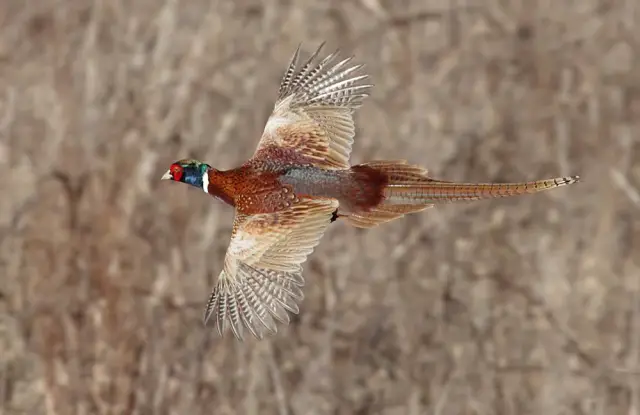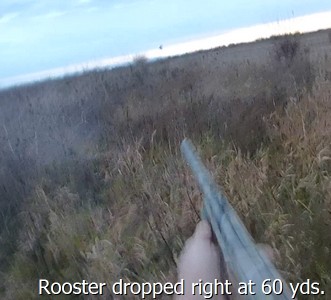


The Best Wild Pheasant Loads
The best of something is always elusive, particularly with shotguns where scant little is exact. Nevertheless the pattern board shows what the differences are or are not although there can be no clinical best for ranges on wild pheasants vary. The wingshooting goal of largest effective spread can only be true for one specific range.
Wild pheasants can hit 60 mph for short distances; add in 25 – 30 mph winds and you have up to 90 mph ground-speed to work with. It is no secret that wild pheasant hunting is one of my favorite pastimes and has been for over forty-five years. Half the fun is watching a good dog work, but if you want “pheasant and wild rice under glass” with no preservatives, artificial colors, flavors, or pen-birds raised on Purina pellets: you need to start walking. What you don't want is “bang” from your shotgun and nothing falling out the sky. The look your dog gives you isn't complimentary.

If a pheasant doesn't
fall dead, we haven't done our job and there is room for improvement.
There is no substitute for a proper pattern, as that is the only interaction
we have with a wary rooster until the dog hands it to us. There is also
no substitute for pellet diameter, pellet sphericity, and an ample payload.
That means a minimum of #5 lead shot and a minimum 1-1/4 oz. payload.
Sure, you can “get by” with less, but getting by is hardly the
point. If I walk four miles, the dog runs about forty miles. That's way
too much walking to throw an anemic load at a pheasant, at least as far
as I'm concerned. Wild pheasants are smart, for they need to be smarter
than hawks and coyotes every day of their lives. Neither hawk nor coyote
populations are anything but overly prosperous in Northern Illinois these
days.
For the record, the shell used on the birds in the video above is the Remington 20 gauge # NT20M5 “Nitro Turkey Buffered Load.” It throws 215 #5 pellets at 1185 fps three-foot velocity, or about 1255 fps actual muzzle velocity with a Trulock Precision Hunter Modified Choke. It is effective on wild pheasants to 60 yards, though at the longer ranges the presentation of the bird may well determine if you want to take the shot or not.
Why number 5 shot? It retains more velocity than smaller shot at all ranges. It offers better penetration than smaller shot, at all ranges. It creates a larger wound channel than smaller shot, at all ranges. It is better at breaking bones than smaller shot, at all ranges. Some might rightly ask, why not #4? No reason why not, but there are problems or at least considerations. The 215 pellets of #5 now shrinks to about 169 pellets and to get the 3 – 4 pellets minimum in the vitals, you'll need to choke up which further reduces effective spread. The heaviest lead payload, out of a 20 gauge, is 1-5/16 oz. To obtain a similar pellet count means 12 gauge with about a 1-5/8 oz. payload and fun to carry 20 gauge gets left at home.

Of course, pheasant
population density varies around the country and so does terrain and typical
shooting distances. If shorter distances are common for you, just use
less choke. If 50 – 55 yard work is common, then use a notch or two
more choke constriction. That's the beauty of choke tubes: you can season
to taste, to insure you'll have more pheasants to season to taste as well.
Copyright 2013 by Randy Wakeman. All Rights Reserved.

Custom Search




